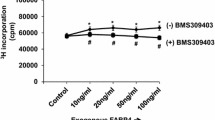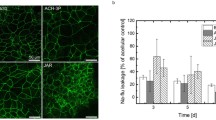Abstract
The present study was undertaken to characterize and identify the insulin-like growth factor binding proteins (IGF BPs) secreted by placental cells and their possible modulatory effect on IGF-I binding to cell surface receptors. The experimental approach taken was comparative characterization of binding and internalization of IGF-I and its analog, [Gln3, Ala4, Tyr15, Leu16 (QAYL)]IGF-I, with reduced affinity for IGF BP, in two different placental cell culture models. One was human placental trophoblast in primary culture and the other, JEG-3 cells, a human choriocarcinoma cell line, representing placental trophoblasts. Binding of [125I]IGF-I in both trophoblast and JEG-3 cells was time and temperature dependent. At 37°C, the plateau of [125I]IGF-I binding to both the cells (1–2% specific binding per 105 cells) was reached by 40–60 min. At 4°C, the time required to reach the plateau in both cells was increased to ∼4h. The maximum binding of [125I]IGF-I to trophoblasts, however, was ∼2 times higher than at 37°C, whereas in JEG-3 cells binding remained the same. Internalization of [125I]IGF-I in trophoblast cells was low and temperature independent. At both 37 and 4°C, ≤30% of the total cell-associated [125I]IGF-I was internalized. In contrast, internalization of [125I]IGF-I in JEG-3 cells was rapid and temperature dependent. At 37°C, ≥60% of the total cell-associated [125]IGF-I was internalized by 40–60min. At 4°C, internalization was slow and did not exceed 10% of the total cell-associated radioactivity. Binding of [125I-QAYL]IGF-I to trophoblasts, in comparison to [125I]IGF-I, was significantly different. The binding was undetectable at 37°C and it was low at 4°C. In JEG-3 cells, however, the binding and internalization of [125I]-QAYL]IGF-I at both the temperatures were comparable to that of [125I]IGF-I. Further characterization of the two [125I]IGF-I bindings to the different placental cells was achieved by binding competition studies using unlabelled IGF-I, [QAYL]IGF-I and [Leu]IGF-I, another analog of IGF-I, [Leu24, 1–62]IGF-I with reduced affinity for the IGF-I receptor, and α-IR3, a monoclonal antibody to the IGF-I receptor. The different potencies of IGF-I and its analogs, and α-IR3 in competing binding of two [125I]IGF-Is in the different cells suggested that binding of IGF-I to JEG-3 cells was predominantly to IGF-I receptor, whereas to trophoblast cells it was to IGF BP. This was confirmed by affinity cross-linking studies. The major affinity cross-linked [125I]IGF-I complex in trophoblast cells was shown to be a protein of Mr. ∼43 kDa, corresponding to IGF BP-3. In JEG-3 cells, the major cross-linked [125I]IGF-I and-[QAYL]IGF-I complexes were proteins of Mr ∼130 kDa and >260 kDa, corresponding to the monomeric and multimeric forms of IGF-I receptor. The ∼43 kDa complex in trophoblast was confirmed to be IGF BP-3 by identification of the characteristics of the IGF BP secreted by trophoblast by Western ligand and immunoblots of the conditioned media. JEG-3 cells did not secrete IGF BP. In conclusion, the membrane associated IGF BP-3 in trophoblast cells, shown here, imply anin vivo modulatory effect of membrane bound IGF BP-3 on IGF-I action in placenta. JEG-3 cells, not secreting IGF-BP, offer an attractive model to study the interactive mechanism of IGF-I and IGF BP-3 actions on the placenta.
Similar content being viewed by others
References
Armstrong, G.D., Hollenberg, M.D., Bhaumick, B. & Bala, R.M. (1983). Bradshaw, R.A., Gill, G.N. (eds). Alan R. Liss Inc.: New York. pp. 227–236.
Baxter, R.C. (1991).Acta Endocrinologica,124, 33–40.
Bala, R.M. & Bhaumick, B. (1979).Can. J. Biochem.,57, 1289–1298.
Bala, R.M., Bhaumick, B., Armstrong, G.H. & Hollenberg, M.D. (1982). Spencer, E.M. (ed). de Grayte-Berlin: New York. pp. 491–507.
Bayne, M.L., Applebaum, J., Chicchi, G.G., Hayes, N.S., Green, B.G. & Cascieri, M.A. (1988).J. Biol. Chem.,263, 6233–6239.
Bhaumick, B. & Bala, R.M. (1985). Ontogeny and characterization of basic somatomedin receptors in rat placenta.Endocrinol.,116, 492–498.
Bhaumick, B. & Bala, R.M. (1987).Endocrinol.,120, 1439–1448.
Bhaumick, B. & Bala, R.M. (1991a).Trophoblast Res.,5, 171–182.
Bhaumick, B. & Bala, R.M. (1991b).Placenta,12, 373.
Bhaumick, B., George, D. & Bala, R.M. (1992).J. Clin. Endocrinol. Metab.,74, 1005–1011.
Cascieri, M.A., Chicchi, G.G., Applebaum, J., Hayes, N.S., Green, B.G. & Bayne, M.L. (1988).Biochem,27, 3229–3233.
Clemmons, D.R., Elgin, R.G., Han, V.K.M., Casella, S.J., D'Ercole, A.J. & Van Wyk, J.J. (1986).J. Clin. Invest.,77, 1548–1556.
Clemmons, D.R., Camacho-Hubner, C., Jones, J.I., McCusker, R.H. & Busby Jr., W.H. (1991). Spencer, E.M. (eds.) Elsevier: New York, Amsterdam, London, Tokyo, pp. 475–486.
Conover, C.A. & Powell, D.R. (1991).Endocrinol,129, 710–716.
Drop, S.L.S., Brinkma, A., Kortleve, D.J., Groffen, C.A.H., Schuller, A. & Zwarthoff, E.C. (1991). Spencer, E.M. (ed). Elsevier: New York, Amsterdam, London, Tokyo, pp. 311–328.
Fant, M. (1990).Placenta,11, 123–133.
Hock, R.A. & Hollenberg, M.D. (1980).J. Biol. Chem.,255, 10731–10736.
Laemmli, U.K. (1970).J. Biol. Chem.,261, 8754–8760.
McCusker, R.H., Camacho-Hubner, C., Bayne, M.L., Cascieri, M.A. & Clemmons, D.R. (1990).J. Cell Physiol. 144, 244–253.
McCusker, R.H., Busby, W.H., Dehoff, M.H., Camacho-Hubner, C. & Clemmons, D.R. (1991).Endocrinol.,129, 939–949.
Ritvos, O., Rutanen, E.-M., Pekonen, F., Jalkanen, J., Suikkari, A.-M. & Ranta, T. (1988a).Endocrinol.,122, 395–401.
Ritvos, O., Ranta, T., Jaklanen, J., Suikkari, A.-M., Voutilainen, V., Bohn, H., Rutanen, E.-M. (1988b).Endocrinol.,122, 2150–2157.
Shimasaki, S., Shimonaka, M., Zhang, H.-P. & Ling, N. (1991). Spencer, E.M. (ed). Elsevier: New York, Amsterdam, London, Tokyo, pp. 343–358.
Yang, Y., Wang, J.F., Orlowski, C., Nissley, S. & Rechler, M. (1989).Endocrinol.,125, 1540–1544.
Author information
Authors and Affiliations
Rights and permissions
About this article
Cite this article
Bhaumick, B., Armstrong, E.A. Differential binding and internalization of insulin-like growth factor (IGF)-I in cultured human trophoblast and JEG-3 cells: possible modulatory effect of IGF binding proteins (BP). Endocr 3, 677–683 (1995). https://doi.org/10.1007/BF02746344
Received:
Accepted:
Issue Date:
DOI: https://doi.org/10.1007/BF02746344




